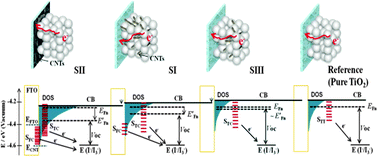Spatial arrangement of carbon nanotubes in TiO2 photoelectrodes to enhance the efficiency of dye-sensitized solar cells†
Abstract
Three electrode structures with different spatial arrangements of

* Corresponding authors
a
Department of Advanced Technology Fusion, Konkuk University, Seoul 143-701, Korea
E-mail:
jjlee@kku.ac.kr
Fax: +82-43-851-4169
Tel: +82-43-840-3580
b Nanotechnology Research Center & Department of Applied Chemistry, Konkuk University, Chungju 380-701, Korea
Three electrode structures with different spatial arrangements of

 Please wait while we load your content...
Something went wrong. Try again?
Please wait while we load your content...
Something went wrong. Try again?
N. C. D. Nath, S. Sarker, A. J. Saleh Ahammad and J. Lee, Phys. Chem. Chem. Phys., 2012, 14, 4333 DOI: 10.1039/C2CP00035K
To request permission to reproduce material from this article, please go to the Copyright Clearance Center request page.
If you are an author contributing to an RSC publication, you do not need to request permission provided correct acknowledgement is given.
If you are the author of this article, you do not need to request permission to reproduce figures and diagrams provided correct acknowledgement is given. If you want to reproduce the whole article in a third-party publication (excluding your thesis/dissertation for which permission is not required) please go to the Copyright Clearance Center request page.
Read more about how to correctly acknowledge RSC content.
 Fetching data from CrossRef.
Fetching data from CrossRef.
This may take some time to load.
Loading related content
